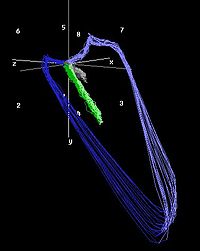
Photo from wikipedia
QRS morphology including left bundle branch block (LBBB) and duration remain the most widely used surrogate markers in the 12-lead electrocardiogram (ECG) for assessing ventricular dyssynchrony and predicting future burden… Click to show full abstract
QRS morphology including left bundle branch block (LBBB) and duration remain the most widely used surrogate markers in the 12-lead electrocardiogram (ECG) for assessing ventricular dyssynchrony and predicting future burden of heart failure (HF) and cardiovascular mortality. However, the vectorcardiographic QRS area has recently been proposed and evidence suggest that this marker may more accurately predict HF development. The aim of this study was to investigate the association between vectorcardiographic QRS area and risk of HF development in LBBB patients. From 2001–2015, the Copenhagen General Practitioners' Laboratory was used to identify patients with a first-time LBBB ECG (QRS>120 ms; LBBB morphology), from which QRS area was derived using the Kors transformation method and grouped into quartiles. Outcome was a composite of HF diagnosis, redeemed prescriptions of loop diuretics, or death from HF. Death from other causes was accounted for as a competing risk. We included a total of 2843 LBBB patients who were free of heart failure (median age, 70 years; female, 58%; ischemic heart disease, 9%). QRS area quartiles comprised Q1, 67–158 μVs; Q2, 159–189 μVs; Q3, 190–228 μVs; and Q4, 229–739 μVs. During 6-month, 1-year, and 5-year follow-up, 9%, 12%, and 28% of patients reached the combined HF endpoint, and 1%, 2%, and 8% of patients died from other causes, respectively (Figure 1). After multivariable adjustment, the highest QRS area quartile, Q4, was associated with increased HF risk (adjusted hazard ratio, 1.64; 95% confidence interval, 1.35–2.00) compared with the lowest quartile, Q1. We did not observe any significant increase in HF risk for remaining quartiles (Q2 or Q3 vs. Q1). Figure 1 Among primary care patients with newly discovered LBBB, a large vectorcardiographic QRS area (229–739 μVs) is associated with increased risk of developing the incident, combined HF endpoint. This indicates that the QRS area derived using the Kors method may serve as a valuable prognostic marker when assessing risk of HF in patients with LBBB.
Journal Title: European Heart Journal
Year Published: 2019
Link to full text (if available)
Share on Social Media: Sign Up to like & get
recommendations!